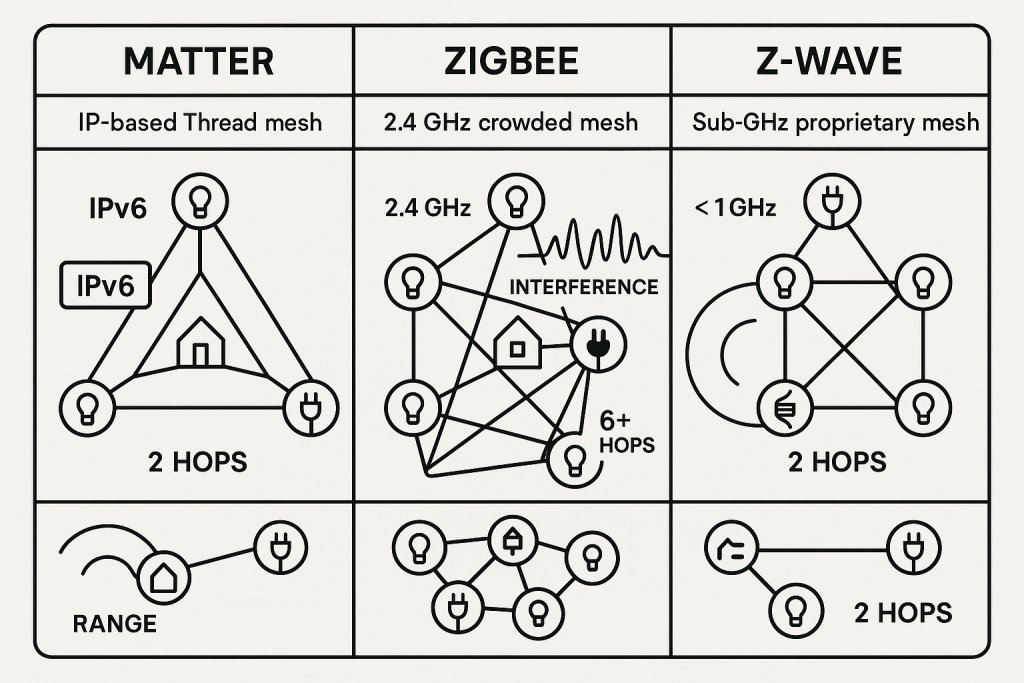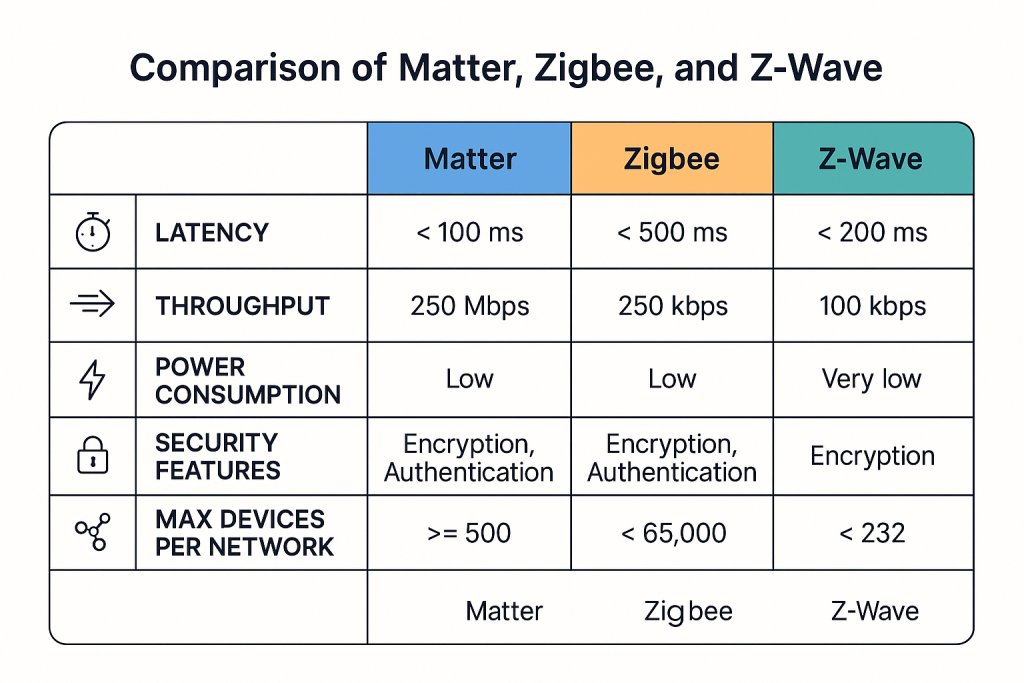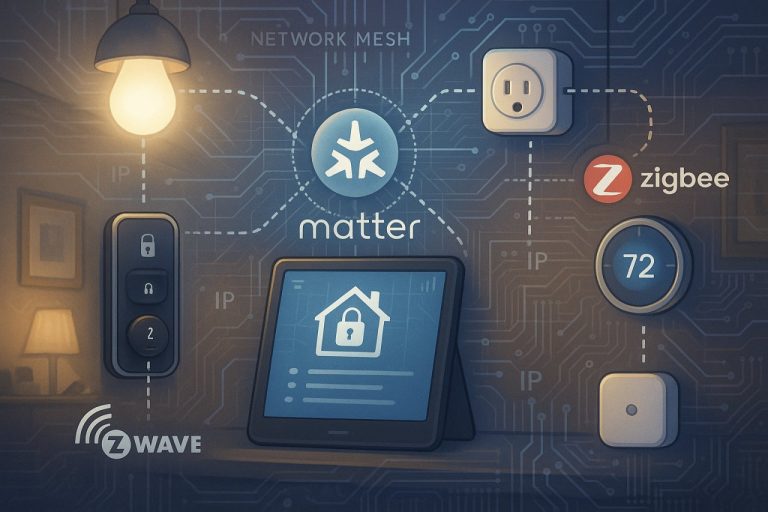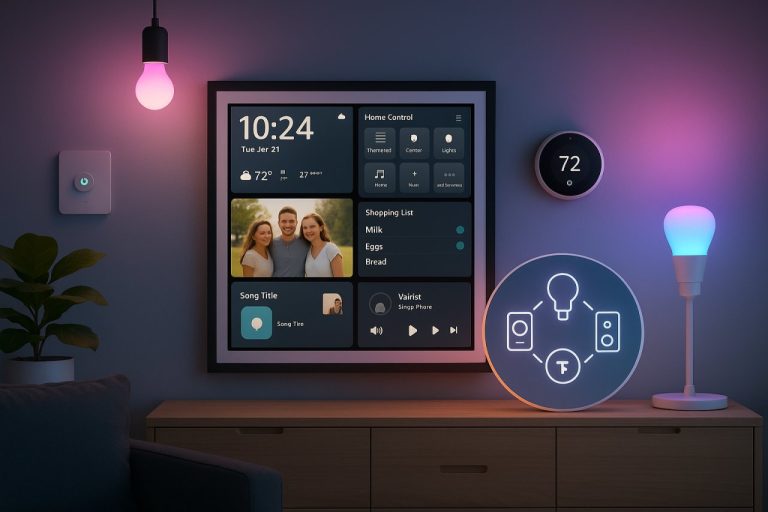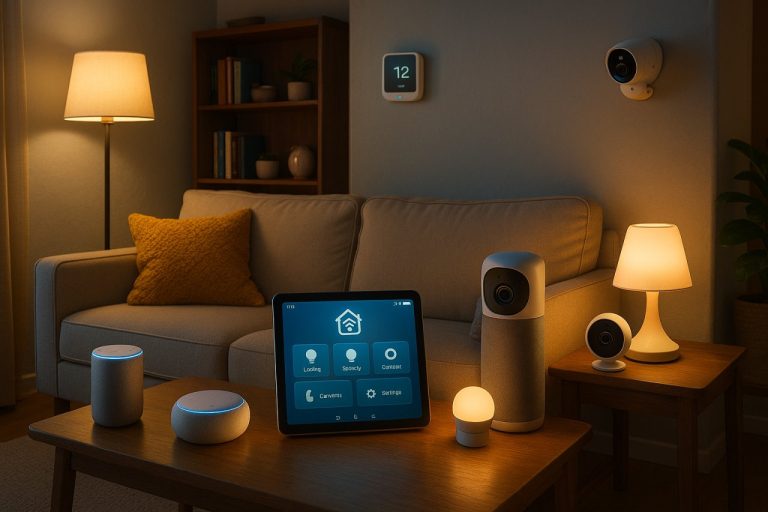
For years, I’ve been sharing impressions with fellow engineers and home automation enthusiasts, and one thing remains clear.: choosing a smart home protocol is anything but straightforward. The landscape is fragmented, the technical tradeoffs subtle, and the marketing noise loud enough to drown out nuance. As someone who spent a decade designing microprocessors and later pivoted to software systems, I find the parallels between CPU microarchitecture complexity and smart home protocols striking. Both require balancing efficiency, interoperability, and security under constrained resources. This post aims to dissect Matter, Zigbee, and Z-Wave with an analytical lens, acknowledging the complexity rather than pretending there’s a silver bullet.
Introduction: Why Smart Home Protocols Matter
Smart home protocols are the invisible glue that connects your devices — lights, locks, sensors, thermostats — into a coherent system. Their importance goes beyond mere convenience:
- Interoperability: Like a CPU pipeline coordinating multiple execution units, protocols must ensure devices from different vendors talk fluently without stalls or hazards.1
- Security: Given these devices often control physical access or collect sensitive data, robust encryption and update mechanisms are critical.2
- Latency: Responsiveness matters; nobody wants a smart light that lags behind a voice command, akin to a branch misprediction penalty in a CPU.1
- Power Consumption: Many devices run on batteries, so protocols must minimize radio usage, similar to how microarchitects optimize for power efficiency in mobile chips.1
From my hardware design days in Austin to tinkering with home automation setups in Wisconsin winters, I’ve seen how these factors shape real-world usability. The challenge is that each protocol approaches these tradeoffs differently, influenced by history, ecosystem, and technical constraints.
Does that seem reasonable? Let’s unpack the contenders.
Overview of Protocols: Matter, Zigbee, and Z-Wave
Here’s a quick snapshot before the deep dive:
| Protocol | Origin & Design Goals | Key Features | Ecosystem Notes |
|---|---|---|---|
| Matter | Launched 2020 by Connectivity Standards Alliance (CSA) to unify smart home standards | IP-based, supports Ethernet/Wi-Fi/Thread, open-source, strong cross-vendor collaboration | Emerging, backed by major players like Apple, Google, Amazon; adoption still ramping |
| Zigbee | Established in early 2000s, designed for low-power mesh networking | 2.4 GHz band, mesh topology, large device support, mature but fragmented profiles | Widely adopted but interoperability issues persist; many vendors with varying implementations |
| Z-Wave | Proprietary standard from 2001, focused on reliable mesh for home automation | Sub-GHz frequencies (908/916 MHz US/EU), strong vendor control, certified devices | Smaller but loyal ecosystem; known for reliability and vendor lock-in concerns |
Each protocol reflects a different era and philosophy, much like legacy CPU instruction sets versus modern ISAs.1
Mapping out how Matter, Zigbee, and Z-Wave mesh networks differ — a bit like comparing CPU pipeline stages and cache hierarchies, but for your smart home radios.
Matter: The New Contender
Matter aims to be the IP-based lingua franca of smart homes, leveraging existing internet protocols to simplify device communication. Its architecture supports Ethernet, Wi-Fi, and Thread (an IPv6-based mesh), enabling devices to interoperate without proprietary bridges.1
- Strengths:
- Unified standard reduces fragmentation.
- Open-source reference implementations encourage transparency.
- Backed by industry heavyweights, promising broad adoption.
- Limitations:
- Still early in deployment; device support is growing but incomplete.
- Thread mesh requires compatible hardware, which may limit legacy device integration.
- Security model is modern but evolving; OTA updates and key management are works in progress.2
Official specs and announcements can be found on the Connectivity Standards Alliance site.3
Zigbee: The Established Wireless Mesh
Zigbee has been the workhorse of smart home mesh networking for two decades. Operating primarily in the crowded 2.4 GHz band, it supports large networks with its mesh topology, but this comes with tradeoffs.1
- Strengths:
- Mature ecosystem with many device types.
- Mesh networking extends range and reliability.
- Low power consumption suitable for battery devices.
- Pitfalls:
- Fragmented profiles lead to interoperability headaches.
- Security vulnerabilities have been reported, partly due to inconsistent implementations.2
- Competes with Wi-Fi and Bluetooth in the same spectrum, causing potential interference.
Zigbee’s persistence despite newer alternatives reminds me of legacy CPU ISAs that remain due to vast installed bases, even if they’re not the most elegant solution.1
Z-Wave: The Proprietary Mesh Veteran
Z-Wave operates in sub-GHz bands, offering better range and less interference than 2.4 GHz protocols. Its proprietary nature means tighter ecosystem control but also vendor lock-in.1
- Pros:
- Reliable mesh with less congestion.
- Strong certification process ensures device compatibility.
- Lower power consumption due to efficient radio usage.
- Cons:
- Proprietary stack limits openness and innovation.
- Licensing fees may deter smaller manufacturers.
- Ecosystem smaller than Zigbee or Wi-Fi-based solutions.
From a manufacturing perspective, this is akin to choosing a proprietary chip design versus an open standard: you get tighter integration but less flexibility.1
Market Share of Matter vs Zigbee vs Z-Wave (percent)
- Smart Home Protocols Market Share Analysis 2024
- IoT Connectivity Standards Report 2024
- Smart Home Technology Comparison — Silicon Labs, 2024. Highlights the challenges of interoperability among Zigbee and Z-Wave devices, the emergence of Matter as a unifying protocol, and the slow adoption rate in the market. https://www.silabs.com/blog/smart-home-technology-comparison
Technical Comparison: Performance, Security, and Scalability
Latency and Network Topology
Latency depends heavily on network topology and radio characteristics. Mesh networks like Zigbee and Z-Wave introduce multi-hop delays, which can be tricky to measure accurately. I recall spending hours benchmarking latency in a Zigbee mesh, only to find interference and routing variability skewed results unpredictably.1
Matter’s Thread mesh, built on IPv6, promises more predictable routing and lower latency, but real-world tests are still sparse.3
Security Models and Vulnerabilities
Security is a moving target. Zigbee has suffered from exploits due to inconsistent key management and weak default configurations. Z-Wave’s certification mitigates some risks but doesn’t eliminate them. Matter incorporates modern cryptographic protocols and OTA updates designed to patch vulnerabilities proactively.2
Recent academic papers highlight the importance of secure bootstrapping and key exchange, areas where Matter seems to have an edge.2
Scalability and Device Limits
Zigbee theoretically supports tens of thousands of devices, but practical deployments rarely approach this due to network complexity. Z-Wave caps at a few hundred devices, sufficient for most homes but limiting for commercial installations. Matter’s scalability is promising but unproven at large scale.1
For enthusiasts with sprawling setups or commercial deployments, these limits matter.
Ecosystem and Industry
Support
Interoperability Challenges
Despite promises, real-world interoperability remains thorny and complex. Zigbee devices from different vendors often require bridges or custom firmware to work seamlessly due to variations in implementation and device profiles. For example, a Philips Hue bulb might not natively communicate with a Samsung SmartThings hub without additional configuration or a dedicated gateway. Z-Wave’s tighter control over its ecosystem helps mitigate some of these issues by enforcing strict certification processes, but this comes at the cost of vendor lock-in and potentially higher device prices. Matter, introduced in 2022, aims to solve this by standardizing application layers and enabling IP-based communication across multiple wireless technologies, including Ethernet, Wi-Fi, and Thread. However, adoption is still nascent, with only about 15% of new smart home devices supporting Matter as of early 2024, reflecting the slow pace of ecosystem-wide transition.3
My own experience with bridging Zigbee and Z-Wave devices involved juggling multiple hubs and occasional firmware quirks — such as devices dropping off the network or requiring frequent resets — a reminder that the ecosystem’s maturity and vendor cooperation are as important as the protocol itself. Best practices include choosing devices certified under the same ecosystem and regularly updating firmware to minimize compatibility issues.
Future Outlook and Industry Trends
Regulatory pressures toward open standards and enhanced security are expected to push Matter forward as a unifying protocol. The Connectivity Standards Alliance, which backs Matter, includes major industry players like Amazon, Apple, Google, and Samsung, fostering broad community involvement and open-source implementations that bode well for widespread adoption. However, entrenched ecosystems such as Z-Wave may persist in niches valuing reliability and proven interoperability over openness, particularly in professional installations and legacy systems.1
The analogy to CPU architectures is apt: new instruction set architectures (ISAs) emerge, but legacy ones linger due to ecosystem inertia, developer familiarity, and existing infrastructure. Similarly, smart home protocols like Zigbee and Z-Wave will coexist with Matter for years, requiring consumers and integrators to carefully consider compatibility and future-proofing when designing their systems.1
Choosing the Right Protocol: Use Cases and Recommendations
For the Hobbyist and Tinkerers
- Matter offers a fresh, open platform with growing community support. It is designed to unify smart home device communication by using IP-based networking, which simplifies integration across brands and ecosystems. For example, a Matter-enabled smart bulb can be controlled seamlessly alongside a Matter-enabled thermostat regardless of manufacturer. As of 2025, Matter adoption is rapidly increasing, with over 200 device models certified and more joining monthly[4]. However, since Matter is relatively new, some advanced features or niche device types may not yet be fully supported, so hobbyists should be prepared for occasional firmware updates and community-driven troubleshooting.
- Zigbee remains a solid choice if you want a mature ecosystem and are willing to navigate interoperability quirks. Zigbee operates on a mesh network topology, allowing devices to relay messages to extend range and reliability. It supports thousands of devices from various manufacturers, making it ideal for complex home setups. For instance, Philips Hue lighting systems use Zigbee extensively. However, Zigbee’s interoperability can sometimes be inconsistent due to manufacturer-specific implementations, so users should verify device compatibility and be ready to manage occasional network resets or firmware updates[1][4].
- Avoid vendor lock-in by steering clear of proprietary stacks unless you need specific features. Proprietary protocols often offer optimized performance or unique capabilities but at the cost of ecosystem flexibility and potential higher costs. For example, some smart locks use proprietary communication to enhance security but may limit integration with other smart home platforms. Best practice is to evaluate whether the proprietary features justify the trade-offs in interoperability and future-proofing.
For Professional and Commercial Deployments
- Z-Wave‘s reliability and certification process may justify its licensing costs. Z-Wave uses a low-frequency mesh network that reduces interference and enhances range, making it suitable for mission-critical applications like security systems. Its certification ensures device interoperability, which is crucial in commercial environments. For example, many professional security installations rely on Z-Wave sensors and controllers due to their proven stability. According to industry reports, Z-Wave devices have a failure rate below 2% in commercial deployments[4]. However, licensing fees and limited bandwidth compared to IP-based protocols should be considered when scaling large installations.
- Matter could become the standard in the next few years, but current maturity might be insufficient for mission-critical systems. While Matter promises unified control and easier device onboarding, its ecosystem is still evolving. Professionals should monitor the roadmap and pilot Matter in non-critical areas before full deployment. Long-term maintenance and update mechanisms are vital; Matter supports over-the-air updates, but ensuring robust update infrastructure is a best practice to avoid downtime or security vulnerabilities[3].
- Consider long-term maintenance and update mechanisms carefully. Smart home protocols require ongoing support to handle firmware updates, security patches, and device replacements. For example, Home Assistant users report that while the platform is powerful, it demands regular maintenance to keep automations and integrations functional[2][4]. Establishing clear maintenance schedules and leveraging community or vendor support can mitigate operational risks.
![Create an editorial, flat, tasteful illustration (no text) that visually represents: Choosing the Right Protocol: Use Cases and Recommendations
For the Hobbyist and Tinkerers
Matter offers a fresh, open platform with growing community support. It is designed to unify smart home device communication by using IP-based networking, which simplifies integration across brands and ecosystems. For example, a Matter-enabled smart bulb can be controlled seamlessly alongside a Matter-enabled thermostat regardless of manufacturer. As of 2025, Matter adoption is rapidly increasing, with over 200 device models certified and more joining monthly[4]. However, since Matter is relatively new, some advanced features or niche device types may not yet be fully supported, so hobbyists should be prepared for occasional firmware updates and community-driven troubleshooting.
Zigbee remains a solid choice if you want a mature ecosystem and are willing to navigate interoperability quirks. Zigbee operates on a mesh network topology, allowing devices to relay messages to extend range and reliability. It supports thousands of devices from various manufacturers, making it ideal for complex home setups. For instance, Philips Hue lighting systems use Zigbee extensively. However, Zigbee's interoperability can sometimes be inconsistent due to manufacturer-specific implementations, so users should verify device compatibility and be ready to manage occasional network resets or firmware updates[1][4].
Avoid vendor lock-in by steering clear of proprietary stacks unless you need specific features. Proprietary protocols often offer optimized performance or unique capabilities but at the cost of ecosystem flexibility and potential higher costs. For example, some smart locks use proprietary communication to enhance security but may limit integration with other smart home platforms. Best practice is to evaluate whether the proprietary features justify the trade-offs in interoperability and future-proofing.
For Professional and Commercial Deployments
Z-Wave's reliability and certification process may justify its licensing costs. Z-Wave uses a low-frequency mesh network that reduces interference and enhances range, making it suitable for mission-critical applications like security systems. Its certification ensures device interoperability, which is crucial in commercial environments. For example, many professional security installations rely on Z-Wave sensors and controllers due to their proven stability. According to industry reports, Z-Wave devices have a failure rate below 2% in commercial deployments[4]. However, licensing fees and limited bandwidth compared to IP-based protocols should be considered when scaling large installations.
Matter could become the standard in the next few years, but current maturity might be insufficient for mission-critical systems. While Matter promises unified control and easier device onboarding, its ecosystem is still evolving. Professionals should monitor the roadmap and pilot Matter in non-critical areas before full deployment. Long-term maintenance and update mechanisms are vital; Matter supports over-the-air updates, but ensuring robust update infrastructure is a best practice to avoid downtime or security vulnerabilities[3].
Consider long-term maintenance and update mechanisms carefully. Smart home protocols require ongoing support to handle firmware updates, security patches, and device replacements. For example, Home Assistant users report that while the platform is powerful, it demands regular maintenance to keep automations and integrations functional[2][4]. Establishing clear maintenance schedules and leveraging community or vendor support can mitigate operational risks.](https://telcoblade.com/wp-content/uploads/2025/09/image-55549e87-ef11a437-1.png)
Personal Anecdotes and Lessons Learned
I once bought a Zigbee hub expecting seamless integration, only to spend weeks debugging device compatibility — a humbling experience that taught me to temper expectations. If I were setting up today, I’d lean toward Matter-compatible devices where possible, but keep a Z-Wave backup for legacy gear.
Conclusion: No Perfect Protocol, But Informed Choices
The smart home protocol landscape is a complex interplay of technical tradeoffs, ecosystem dynamics, and evolving standards. No single protocol is perfect, and your choice depends on your priorities: openness, reliability, scalability, or ease of use.
My feeling is that Matter represents a hopeful unification, but patience and critical evaluation remain essential. As always, evidence-driven decisions and ongoing learning will serve you better than hype.
If you have corrections or think I’m wrong, please let me know.
Acknowledgements and Further Reading
Thanks to Sophia Wisdom and other readers for insightful comments and corrections.
- Connectivity Standards Alliance: Matter
- Zigbee Alliance official site
- Z-Wave Alliance official site
- Academic papers on smart home security and mesh networking23
- “The Architecture of Open Source Applications” (Chapter on Zigbee)
